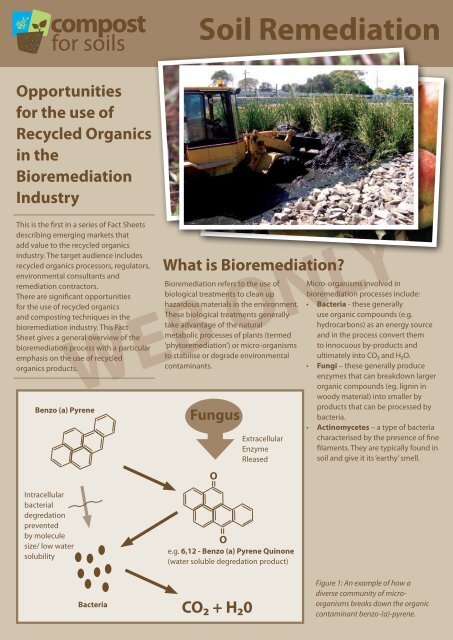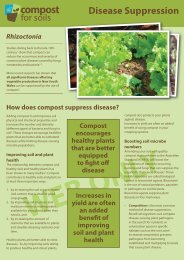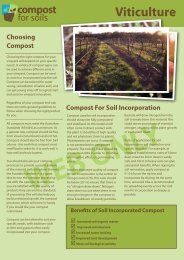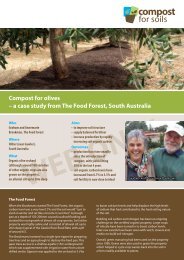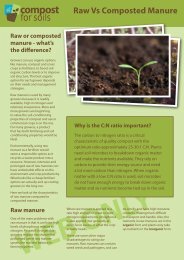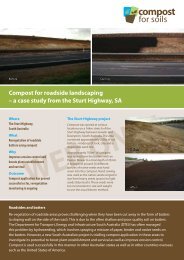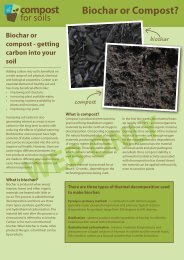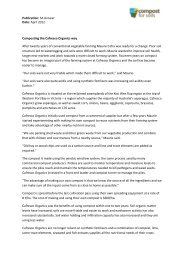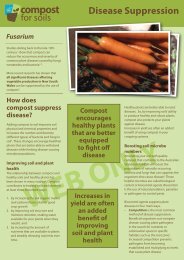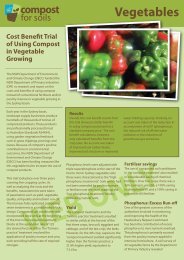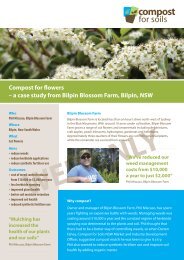What is Bioremediation? - Compost for Soils
What is Bioremediation? - Compost for Soils
What is Bioremediation? - Compost for Soils
You also want an ePaper? Increase the reach of your titles
YUMPU automatically turns print PDFs into web optimized ePapers that Google loves.
ocompost <strong>for</strong> soilsSoil RemediationOpportunities<strong>for</strong> the use ofRecycled Organicsin the<strong>Bioremediation</strong>IndustryTh<strong>is</strong> <strong>is</strong> the first in a series of Fact Sheetsdescribing emerging markets thatadd value to the recycled organicsindustry. The target audience includesrecycled organics processors, regulators,environmental consultants andremediation contractors.There are significant opportunities<strong>for</strong> the use of recycled organicsand composting techniques in thebioremediation industry. Th<strong>is</strong> FactSheet gives a general overview of thebioremediation process with a particularemphas<strong>is</strong> on the use of recycledorganics products.Benzo (a) PyreneIntracellularbacterialdegredationpreventedby moleculesize/ low watersolubility<strong>What</strong> <strong>is</strong> <strong>Bioremediation</strong>?<strong>Bioremediation</strong> refers to the use ofbiological treatments to clean uphazardous materials in the environment.These biological treatments generallytake advantage of the naturalmetabolic processes of plants (termed‘phytoremediation’) or micro-organ<strong>is</strong>msto stabil<strong>is</strong>e or degrade environmentalcontaminants.FungusO==OExtracellularEnzymeRleasede.g. 6,12 - Benzo (a) Pyrene Quinone(water soluble degredation product)Micro-organ<strong>is</strong>ms involved inbioremediation processes include:• Bacteria - these generallyuse organic compounds (e.g.hydrocarbons) as an energy sourceand in the process convert themto innocuous by-products andultimately into CO2 and H2O.• Fungi – these generally produceenzymes that can breakdown largerorganic compounds (eg. lignin inwoody material) into smaller byproducts that can be processed bybacteria.• Actinomycetes – a type of bacteriacharacter<strong>is</strong>ed by the presence of finefilaments. They are typically found insoil and give it its ‘earthy’ smell.BacteriaCO2 + H20Figure 1: An example of how adiverse community of microorgan<strong>is</strong>msbreaks down the organiccontaminant benzo-(a)-pyrene.
Benefits<strong>Bioremediation</strong> offers the followingadvantages over other remediationmethods:• Generally cheaper than traditionalphysical and chemical remediationtechnologies;• Environmentally friendly (convertsmost contaminants to water, carbondioxide and innocuous by-products);Contaminated Soil• Environmentally sustainable(treated soil can often be reusedon-site avoiding landfill d<strong>is</strong>posal);• The process harnesses the highlyspecific and efficient metabolicprocesses of naturally occurringorgan<strong>is</strong>ms.Limitations<strong>Bioremediation</strong> has the followinglimitations:• Certain poly aromatic hydrocarbons(e.g. benzo-(a)-pyrene) andchlorinated compounds (e.g.Polychlorinated biphenyls) arerecalcitrant to biodegradation.Inorganic contaminants such asheavy metals are not degraded bybioremediation (even though it canass<strong>is</strong>t to ‘lock them up’);• <strong>Bioremediation</strong> <strong>is</strong> a relatively slowprocess generally taking from severalmonths to several years to complete;• Sometimes contaminants are not‘bio-available’ which mean that theyare so strongly bound to the soilstructure that they are not accessibleto micro-organ<strong>is</strong>ms;• Extreme environmental conditions(e.g. salt, pH, nutrients) or highconcentrations of contaminants canbe toxic to micro-organ<strong>is</strong>ms.Target Contaminants<strong>Bioremediation</strong> can effectively degrade or stabil<strong>is</strong>e a wide range ofcontaminants. These are summar<strong>is</strong>ed in the table below:Chemical ContaminantPAH (Poly Aromatic Hydrocarbons)PCP (Pentachlorophenol)Total PhenolsHeavy Metals (stabil<strong>is</strong>ation)TPH (Total PetroleumHydrocarbons)BTEX (benzene, toluene, ethylbenzene,xylene)TNT (Trinitrotoluene)Common SourcesGas works, wood treatments (eg.creosote), industrial byproductsBiocides used in wood treatments, oilsand paintsWood treatments, general industryDiverse industries, metal works,tanneries, refineries, smelters, miningPetroleum products, service stations,refineries, waste oilPetroleum products, service stations,refineriesExplosives, mining and defenceindustriesExample of the ma
<strong>Bioremediation</strong>TechnologiesThere are a number of differentbioremediation technologies used toclean up contaminated sites. Theseinclude:• Bioreactors (or bioslurry)– treatment of a contaminatedsubstance in a tank containingorgan<strong>is</strong>ms or enzymes;• Bioventing – involves the venting ofoxygen through soil to stimulate thegrowth of natural and introducedbioremediation organ<strong>is</strong>ms;• Co-<strong>Compost</strong>ing – generally involvesmixing contaminated materialswith either mature compost or freshrecycled organics. The mixtures are<strong>for</strong>med into turned windrows orengineered biopiles (see below);• Biopiles – specially engineeredstatic piles of mixed contaminatedsoil and remediation amendmentsusually involving a network ofpumps and pipes <strong>for</strong> <strong>for</strong>ced aeration;• Landfarming – the use of farmingtilling and soil amendmenttechniques to encourage the growthof bioremediation organ<strong>is</strong>ms in acontaminated area.Using RecycledOrganics <strong>for</strong><strong>Bioremediation</strong>Recycled organics are used extensivelyin bioremediation and in many casesunderpin the basic requirementsof the process. Often referred toas ‘co-composting’, the process <strong>is</strong>similar to commercial compostingwhere windrows are constructed andtechnical parameters are monitoredto ensure that optimal conditions <strong>for</strong>biodegradation are maintained.Recycled organics provide a numberof benefits when util<strong>is</strong>ed in thebioremediation process:• A complex microbial communitywith a wide range of metaboliccapabilities;• Macro nutrients such as nitrogen,phosphorus and potassium;• Trace elements essential <strong>for</strong>microbial growth;• High porosity <strong>for</strong> the supply ofoxygen and diffusion of air;• Increased water holding capacity;• Buffering capacity (particularly <strong>for</strong>high or low pH soils);• Heat generation allowingincreased bio-availability of somecontaminants.Extracting contaminated soilIn bioremediation processes where<strong>for</strong>ced aeration <strong>is</strong> used (e.g. biopiles,bioventing) a ‘biofilter’ <strong>is</strong> oftenemployed to mitigate the em<strong>is</strong>sionof volatile compounds. Recycledorganics (normally mature compostand coarse woodchips) are often a keycomponent of the biofilter medium.chinery used in the bioremediation process


